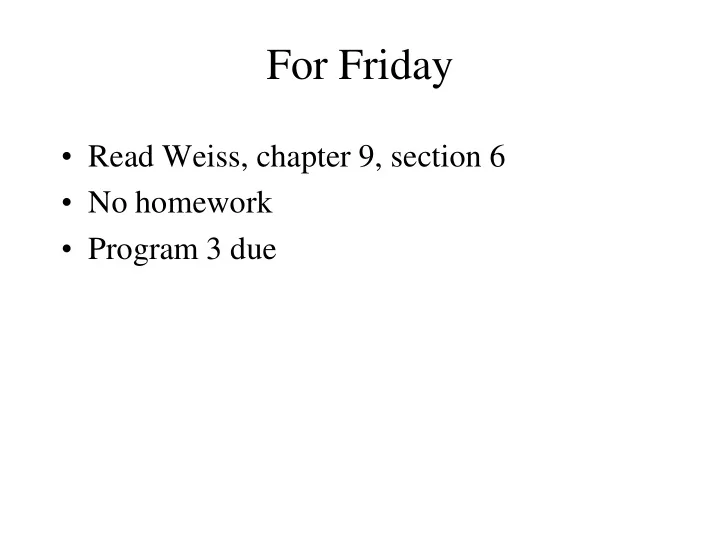

For Friday • Read Weiss, chapter 9, section 6 • No homework • Program 3 due
Program 3 • Questions?
Weighted Graphs • Dykstra’s algorithm • A greedy algorithm • A form of best-first search
Negative Weights Problem
Network Flow • We have a weighted directed graph with a source and a sink--a network. • Note that cycles are possible. • Each edge’s weight represent the maximum possible flow through that edge. • We want to determine the maximum possible flow through the network and a way to achieve that maximum.
Ford-Fulkerson Method • Start with 0 flow in the network • Repeat – Select a path from source to sink with no full forward edges or a non-full backward edge. – Increase flow by maximum possible amount on that path • Until no paths can be selected • You now have maximal flow
Selecting a Path to Augment • If you select the longest path, problems can arise. • If the shortest available path is used at every iteration: the number of paths used before maximum flow is found is less than VE • Can be improved by using the path with the best improvement to flow at each iteration.
Critical Path • The longest path between two nodes • For what kind of graph is this meaningful? • Why would we want to compute it? • How could we compute it?
Transitive Closure • The problem is: for each node in the graph, what other nodes can be reached from that node? • Not an issue in an undirected graph. Why? • Can be done be doing a search from each node and discovering all of the nodes that can be found from each node.
Transitive Closure (cont.) • Depth First Search can be used to compute the transitive closure of a graph represented with an adjacency list in O(V(V+E)) time. • DFS can be used to compute the transitive closure of a graph represented with an adjacency matrix in O(V 3 ) time.
Warshall’s Algorithm • Note that if there is a path from X to Y and there is a path from Y to Z, then there is a path from X to Z • for (y = 0; y < V; y++) for (x = 0; x < V; x++) if (a[x][y]) for (j = 0; j < V; j++) if (a[y][j]) a[x][j] = 1;
All Shortest Paths • In sparse matrix, just run Dykstra’s algorithm for each vertex • In dense graphs, use a matrix and use an algorithm similar to Warshall’s algorithm • Computes all shortest paths in O(V 3 ) time • To determine actual path, need an additional matrix.
Floyd’s Algorithm • for (y = 0; y < V; y++) for (x = 0; x < V; x++) if (a[x][y]) for (j = 0; j < V; j++) if (a[y][j] > 0) if (!a[x][j] || (a[x][y] + a[y][j] < a[x][j])) a[x][j] = a[x][y] + a[y][j];
Minimum Spanning Tree • Useful to solve problems like: what’s the cheapest way to connect a set of points to each other • Can be solved using a greedy algorithm • So we can use best-first search (search using a priority queue) • Applies to undirected graphs
Minimum Spanning Trees • Prim’s algorithm Select a node to put in the spanning tree while some nodes are not in the tree select the shortest edge connecting a node in the tree to a node NOT in the tree add that edge and node to the tree end while
Minimum Spanning Trees • Kruskal’s Algorithm while not all nodes are in a single tree select the shortest edge with at least one end node not currently in a tree or connecting to trees to each other add that edge and its end nodes to the tree end while
Graph Searching • Depth-first • Breadth-first • Best-first
Applications of Searching • Connectivity in an undirected graph
Bi-Connectivity
Euler Circuits
Recommend
More recommend